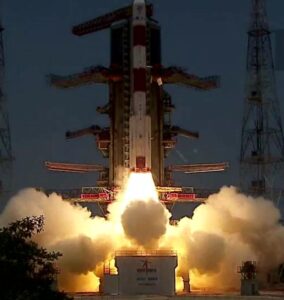The Aditya L1 mission – Indian Space Research Organisation (ISRO) launches solar mission – Key Scientific Objectives & Phases
Aditya L1 positioned approximately 1.5 million kilometers (932,000 miles) away from Earth, which is about 1% of the Earth-Sun distance. India’s space agency estimates that it will take four months to cover this distance.
This pioneering space mission, India’s first to study the solar system’s largest celestial body, is named after Surya, the Hindu deity representing the Sun, known as Aditya.

The “L1” in Aditya-L1 denotes Lagrange point 1, the precise location between the Sun and Earth where the Indian spacecraft will be stationed.
Also Read:- European Space Agency’s Contribution to ISRO’s Aditya-L1 Solar Mission
The Indian Space Research Agency (ISRO) has revealed that after the spacecraft’s initial launch, it will follow several orbits around Earth before being directed towards its final destination at L1.
Once positioned there, The Aditya L1 will have the capability to continuously observe the Sun, including during events like eclipses, facilitating various scientific research activities.
The Aditya L1 – Key scientific objectives
- Investigating the dynamics of the solar upper atmosphere, encompassing the chromosphere and corona.
- Exploring chromospheric and coronal heating, the physics of partially ionized plasma, the initiation of coronal mass ejections, and solar flares.
- Observing in-situ particle and plasma conditions to provide data for understanding particle dynamics originating from the Sun.
- Examining the physics of the solar corona and its mechanisms of heating.
- Conducting diagnostics of plasma in the coronal region and coronal loops, including temperature, velocity, and density.
- Studying the development, dynamics, and origins of Coronal Mass Ejections (CMEs).
- Identifying the sequence of processes occurring at multiple layers (chromosphere, base, and extended corona) that lead to solar eruptive events.
- Analyzing magnetic field topology and measurements within the solar corona.
- Investigating the drivers for space weather, including the origin, composition, and dynamics of the solar wind.
The Aditya L1 – Phases
- Rocket Ignition
- Ignition of two air-lift PSOMs
- Separation of four Ground-Lit PSOMs
- Separation of two air-lift PSOMs
- PS-1 separation
- PS2 ignition
- Heatshield separation
- PS2 separation
- HPS3 ignition
- HPS3 separation
- First ignition of PS4
- First cut-off of PS4
- Second ignition of PS4
- Second cut-off from PS4
- Satellite separation
Here is the brochure: https://t.co/5tC1c7MR0u
and a few quick facts:
🔸Aditya-L1 will stay approximately 1.5 million km away from Earth, directed towards the Sun, which is about 1% of the Earth-Sun distance.
🔸The Sun is a giant sphere of gas and Aditya-L1 would study the… pic.twitter.com/N9qhBzZMMW— ISRO (@isro) September 1, 2023
Watch the historic moment
#WATCH | Indian Space Research Organisation (ISRO) launches India’s first solar mission, #AdityaL1 from Satish Dhawan Space Centre in Sriharikota, Andhra Pradesh.
Aditya L1 is carrying seven different payloads to have a detailed study of the Sun. pic.twitter.com/Eo5bzQi5SO
— ANI (@ANI) September 2, 2023
During the live updates of the Aditya L1 launch, the PSLV rocket slowly ascended into the sky, sporting a prominent orange flame at its tail.
It gained velocity with a rumbling sound reminiscent of rolling thunder, ascending higher and higher, leaving behind a dense trail of exhaust.
The audience gathered at the viewing gallery responded with applause and pride. Notably, this mission stands as one of the longest for both the rocket and the Indian Space Research Organisation (ISRO).
Approximately 63 minutes after liftoff, the rocket will release the Aditya-L1 spacecraft, marking the mission’s conclusion at around the 73-minute mark when the fourth stage is deactivated.
The flight plan involves shutting down the rocket’s fourth stage twice, allowing for a coasting phase lasting approximately 30 minutes: first, 26 minutes after the initial cutoff, and then, around 3 minutes after the second cutoff.
The Aditya L1 launch – Images and footage
Indian Space Research Organisation (ISRO) launches solar mission, #AdityaL1 from Satish Dhawan Space Centre in Sriharikota pic.twitter.com/n980WYkbRk
— ANI (@ANI) September 2, 2023
While ISRO has not officially disclosed the mission’s cost, Indian media reports estimate it to be approximately 3.78 billion rupees ($46 million; £36 million). Checkout AdityaL1 Mission Brochure – https://www.isro.gov.in/media_isro/pdf/AdityaL1_Mission_Brochure.pdf






